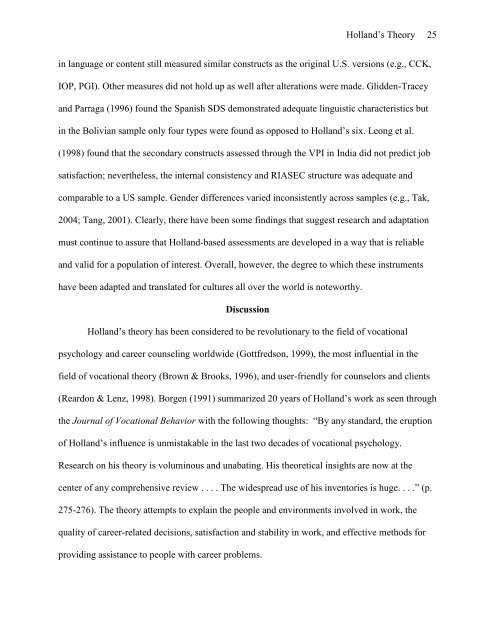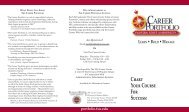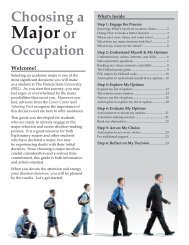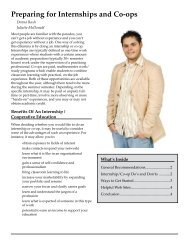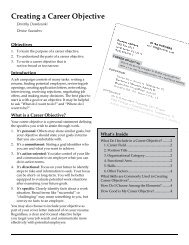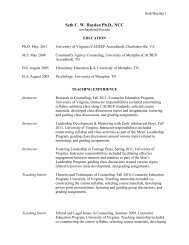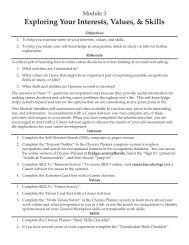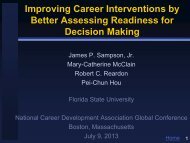Holland's Theory in a Post-Modern World: - The Career Center ...
Holland's Theory in a Post-Modern World: - The Career Center ...
Holland's Theory in a Post-Modern World: - The Career Center ...
Create successful ePaper yourself
Turn your PDF publications into a flip-book with our unique Google optimized e-Paper software.
Holland’s <strong><strong>The</strong>ory</strong> 25<strong>in</strong> language or content still measured similar constructs as the orig<strong>in</strong>al U.S. versions (e.g., CCK,IOP, PGI). Other measures did not hold up as well after alterations were made. Glidden-Traceyand Parraga (1996) found the Spanish SDS demonstrated adequate l<strong>in</strong>guistic characteristics but<strong>in</strong> the Bolivian sample only four types were found as opposed to Holland’s six. Leong et al.(1998) found that the secondary constructs assessed through the VPI <strong>in</strong> India did not predict jobsatisfaction; nevertheless, the <strong>in</strong>ternal consistency and RIASEC structure was adequate andcomparable to a US sample. Gender differences varied <strong>in</strong>consistently across samples (e.g., Tak,2004; Tang, 2001). Clearly, there have been some f<strong>in</strong>d<strong>in</strong>gs that suggest research and adaptationmust cont<strong>in</strong>ue to assure that Holland-based assessments are developed <strong>in</strong> a way that is reliableand valid for a population of <strong>in</strong>terest. Overall, however, the degree to which these <strong>in</strong>strumentshave been adapted and translated for cultures all over the world is noteworthy.DiscussionHolland’s theory has been considered to be revolutionary to the field of vocationalpsychology and career counsel<strong>in</strong>g worldwide (Gottfredson, 1999), the most <strong>in</strong>fluential <strong>in</strong> thefield of vocational theory (Brown & Brooks, 1996), and user-friendly for counselors and clients(Reardon & Lenz, 1998). Borgen (1991) summarized 20 years of Holland’s work as seen throughthe Journal of Vocational Behavior with the follow<strong>in</strong>g thoughts: “By any standard, the eruptionof Holland’s <strong>in</strong>fluence is unmistakable <strong>in</strong> the last two decades of vocational psychology.Research on his theory is volum<strong>in</strong>ous and unabat<strong>in</strong>g. His theoretical <strong>in</strong>sights are now at thecenter of any comprehensive review . . . . <strong>The</strong> widespread use of his <strong>in</strong>ventories is huge. . . .” (p.275-276). <strong>The</strong> theory attempts to expla<strong>in</strong> the people and environments <strong>in</strong>volved <strong>in</strong> work, thequality of career-related decisions, satisfaction and stability <strong>in</strong> work, and effective methods forprovid<strong>in</strong>g assistance to people with career problems.


